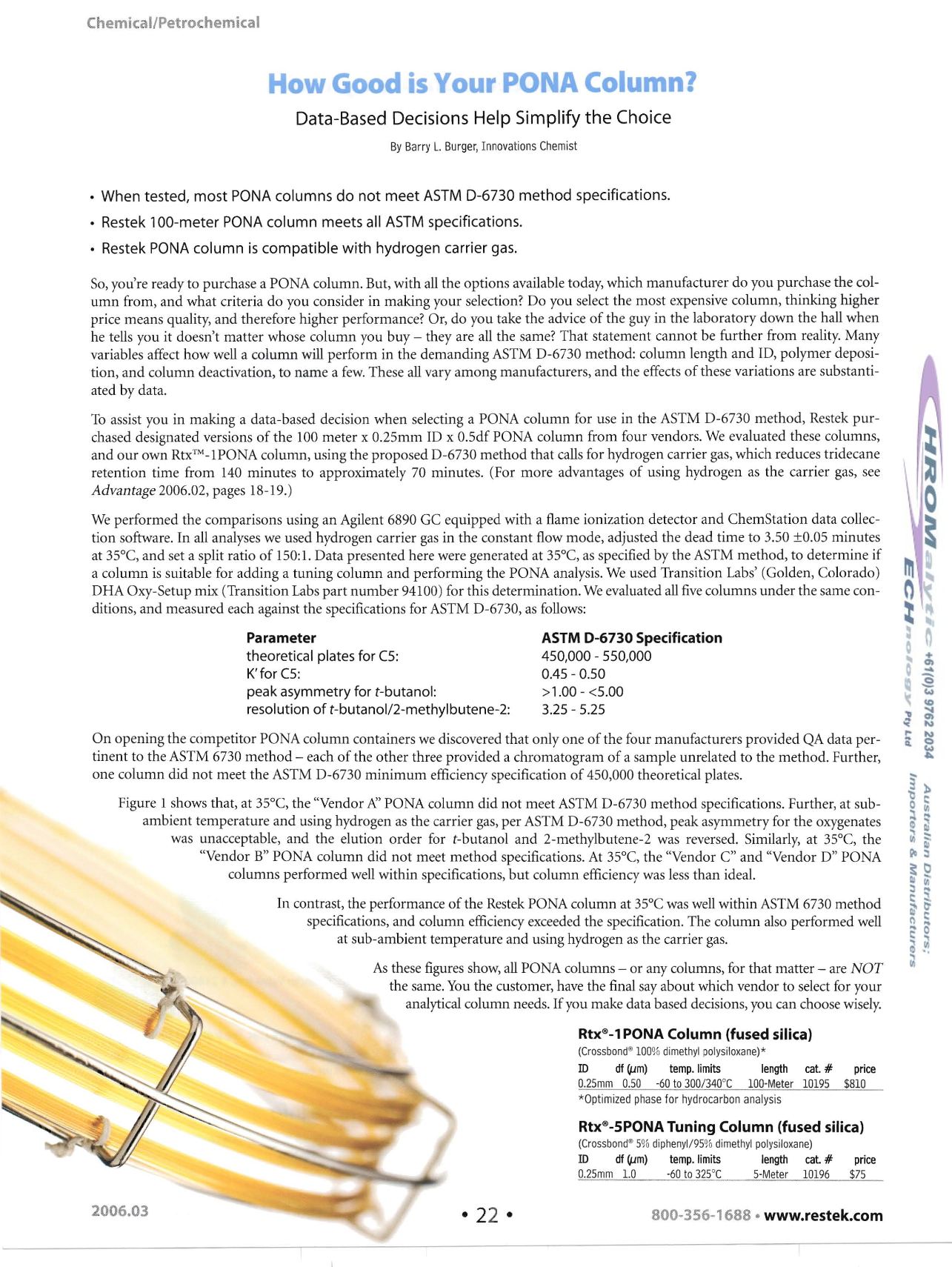

Chemical/Petrochemical
How Good isYour PONA Column?
Data-Based Decisions Help Simplify the Choice
ByBarry
L.
Burger,Innovations Chemist
• When tested, most PONA columns do not meet ASTM 0-6730 method specifications.
• Restek 1OO-meter PONA column meets all ASTM specifications.
• Restek PONA column is compatible w ith hydrogen carrier gas.
So, you're ready to purchase a PONA column. But, with all the options available today, which manufactur er do you purchase the col
umn from, and what criteria do you consider in making your selection? 0 0 you select the most expensive column, thinking higher
price means quality, and therefore higher performance? Or, do you take the advice of the guy in the laboratory down the hall when
he tells you it doesn't matter whose column you buy - they are all the same? That statement cann ot be further from reality. Many
variables affect how well a column will perform in the demand ing ASTM 0-6730 method: column length and ID, polymer deposi
tion, and column deactivation , to name a few. These all vary amo ng manu factur ers, and the effects of these variations are substanti
ated by data.
To assist you in making a data-based decision when selecting a PONA column for use in the ASTM 0-6730 method, Restek pur
chased designated versions of th e 100 meter x 0.25mm ID x 0.5df PONA column from four vendors. We evaluated these columns,
and our own Rtx™- IPONA column, using the proposed 0 -6730 method that calls for hydrogen carrier gas, which redu ces tridecane
retention time from 140 minutes to approximately 70 minutes. (For more advantages of using hydrogen as the carr ier gas, see
Advan tage
2006.02, pages 18-19.)
We performed the compar isons using an Agilent 6890 GC equipped with a flame ionization detector and ChemStat ion data collec
tion software. In all analyses we used hydrogen carrier gas in the constant flow mode, adjusted the dead time to 3.50 ±0.05 minut es
at 35°C, and set a split ratio of 150:
1.
Data presented here were generated at 35°C, as specified by the ASTM meth od , to determine if
a column is suitable for adding a tuning column and performing the PONA analysis. We used Transition Labs' (Golden, Colorado)
OHA Oxy-Setup mix (Transition Labs part number 94100) for this
determination.Weevaluated all five columns und er the same con
ditions, and measured each against the specifications for ASTM 0 -6730, as follows:
Parameter
ASTM0-6730 Specification
theoretical plates for (5:
450,000 - 550,000
K'for (5:
0.45 -0.50
peak asymmetry for t-butanol:
>
1.00 - <5.00
resolution of t-butanoI/2-methylbutene-2:
3.25 - 5.25
On opening the com petitor PONA column containers we discovered that only one of the four manufactur ers provided QA data per
tinent to the ASTM 6730 method - each of the other thr ee provided a chromatogram of a samp le unrelated to the meth od. Fur ther,
one column did not meet the ASTM 0-6730 minimum efficiency specification of 450,000 theoretical plates.
Figure 1 shows that, at 35°C, the "Vendor
PC'
PONA column did not meet ASTM 0 -6730 method specifications. Further, at sub
ambient temp erature and using hydrogen as the carrier gas, per ASTM 0 -6730 method, peak asymme try for the oxygenates
was un acceptable, and the elution order for t-but anol and 2-methylbutene-2 was reversed. Similarly, at 35°C, the
"Vendor B" PONA column did not meet method specifications. At 35°C, the "Vendor
C"
and "Vendor 0 " PONA
columns perform ed well within specifications, but column efficiency was less than ideal.
In cont rast, the perform ance of the Restek PONA column at 35°Cwas well within ASTM 6730 method
specifications, and column efficiency exceeded the specification. The column also performed well
at sub-ambient temperature and using hydrogen as the carr ier gas.
As these figures show, all PONA columns - or any columns, for that matter - are
NOT
the same. You the customer, have the final say about which vendor to select for your
analytical column needs. If you make data based decisions, you can choose wisely.
Rtx"'-l PONA Column (fused silica)
(Crossbond" 100%dimethyl polysiloxane)*
ID
df
(um)
temp. limits
length
cat.
#
price
0.25mm 0.50 -60to 300/340°C
100-Meter 10195 $810
*Optimized phase for hydrocarbonanalysis
Rtx"'-5PONATuning Column (fused silica)
(Crossbond" 5%diphenyl/95%dimethyl polysiloxane)
ID
df (um)
temp. limits
length
cat.
#
price
0.25mm 1.0
-60 to 325°C
5-Meter 10196
$75
2006.03
800-356-1688 •
www.restek.com• 22 •
Website :
www.chromtech.net.auE-mail :
info@chromatech.net.auTelNo : 03 9762 2034 . . . in AUSTRALIA











